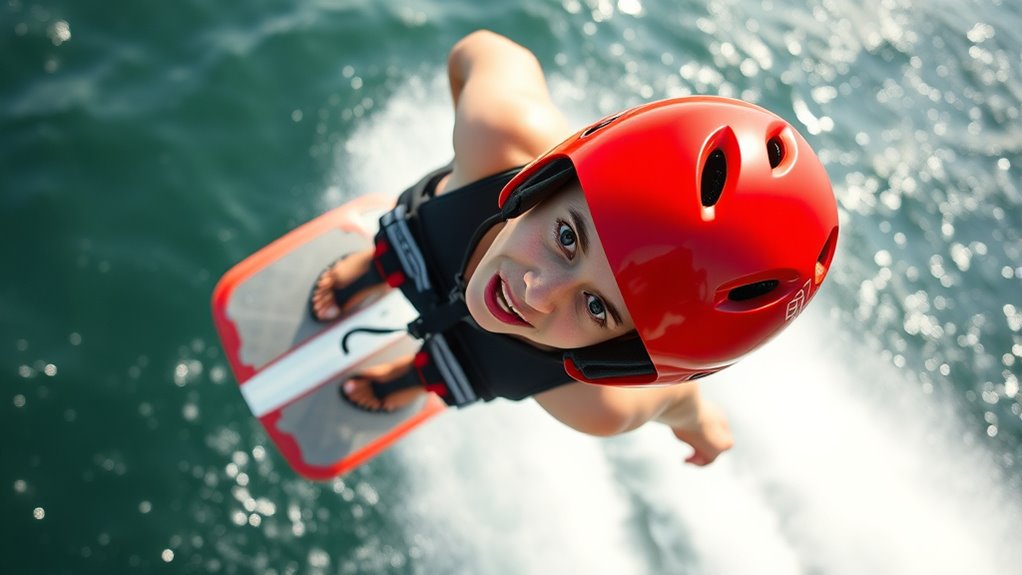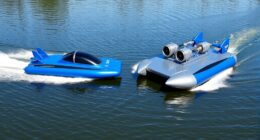On your first day flyboarding, one common mistake is wearing a helmet that’s too loose or too tight, risking shifting or discomfort. Many new riders forget to check and adjust the straps properly, which can compromise safety and confidence. Failing to inspect the helmet for damage or neglecting regular fit checks can also lead to mishaps. Ensuring a snug, comfortable fit and maintaining your gear is key—keep going to learn more about avoiding these mistakes.
Key Takeaways
- Failing to check helmet fit before each session, leading to discomfort or reduced protection.
- Not adjusting straps snugly, causing helmet wobbling or slipping during flyboarding.
- Using a damaged or improperly maintained helmet, compromising safety.
- Wearing a helmet that’s too tight or too loose, resulting in headaches or decreased stability.
- Ignoring the importance of regular fit checks as hair or accessories may alter helmet positioning.

Starting flyboarding can be exciting, but new riders often make common mistakes with their helmets that can impact safety and confidence. One of the most frequent issues is neglecting safety gear errors, especially when it comes to helmet fit. Many beginners underestimate how essential proper helmet adjustment is, thinking a standard size will do for everyone. However, an improperly fitted helmet can shift during your ride, reducing protection and distracting you from focusing on your balance and technique. It might seem minor, but a loose helmet can slide forward or backward, exposing your head to potential injury if a fall occurs. Conversely, a helmet that’s too tight can cause discomfort, headaches, or even restrict your vision, which isn’t ideal when you need full awareness of your surroundings.
Proper helmet fit is crucial for safety and confidence during flyboarding.
When you first put on your helmet, don’t just throw it on and assume it’s fine. Take the time to adjust the straps properly. The chin strap should be snug but comfortable, allowing you to fit your finger between the strap and your chin. If it’s too loose, the helmet can wobble during movement, compromising your safety. If it’s too tight, it might cause pressure points that lead to headaches or discomfort, which can distract you while you’re trying to learn. Many new flyboarders overlook these details, assuming that a quick fit is enough. But ensuring a proper fit is key to staying protected and confident as you learn to control your board.
Another common mistake is failing to check the helmet’s fit before each session. Your head shape can change slightly if you wear hats or hair accessories, and even minor adjustments can make a difference. Always recheck the fit, especially if you’re switching helmets or if your helmet has been stored for a while. Remember, safety gear errors like an ill-fitting helmet don’t just affect your protection—they can also undermine your confidence. Feeling secure in your helmet allows you to focus on mastering your skills instead of worrying about whether your gear will stay in place. Additionally, proper helmet maintenance ensures continued protection and longevity of your safety equipment.
Finally, some beginners don’t realize that helmets should be replaced after a crash or significant impact. Even if the damage isn’t visible, the helmet’s protective integrity can be compromised. Ignoring this can be a critical safety mistake. Make sure you inspect your helmet regularly and replace it if you experience a fall or if it shows signs of wear. Taking these simple steps ensures that your helmet provides the best protection possible, helping you to enjoy flyboarding safely and with confidence from your very first day.
Frequently Asked Questions
What Types of Helmets Are Safest for Flyboarding?
When choosing a helmet for flyboarding, you want one with the safest helmet material, like high-impact ABS or polycarbonate, to protect your head. Make sure it has good helmet ventilation to keep you cool and comfortable during your ride. Always select a helmet that fits snugly and is certified for water sports. This guarantees you stay protected, comfortable, and safe while enjoying your flyboarding adventure.
How Often Should I Replace My Flyboarding Helmet?
You should replace your flyboarding helmet when it shows signs of damage, like cracks or compromised helmet ventilation, or if it feels notably heavier or less comfortable over time. Regularly inspecting the helmet ensures proper helmet ventilation and reduces strain from excessive helmet weight. Don’t wait until discomfort or safety concerns arise—routine replacement keeps you protected and comfortable, especially as materials degrade or after impacts.
Can Wearing a Helmet Improve My Flyboarding Performance?
Wearing a helmet can definitely improve your flyboarding performance by boosting confidence and safety. Many believe it might hinder helmet comfort or visibility, but modern helmets are designed for both. When you choose a well-fitting helmet, it stays comfortable during your session and doesn’t obstruct your view. This clarity helps you focus better, react faster, and stay safe, ultimately enhancing your overall flyboarding experience.
Are There Specific Helmet Fit Guidelines for Beginners?
When choosing a helmet for your first flyboarding experience, focus on fit guidelines that guarantee helmet comfort and safety. Make sure it fits snugly without causing pressure points, and adjust the straps properly. Your helmet color choices also matter; bright colors can boost visibility. Proper fit prevents distractions, so you can concentrate on your ride. Remember, comfort and visibility are key to a safe, enjoyable flyboarding adventure.
What Safety Certifications Should a Flyboarding Helmet Have?
Think of a flyboarding helmet as your shield in the water battlefield. It should meet certification standards like CE, ASTM, or EN 1385, ensuring it’s tested for impact and water resistance. Look for helmets made from durable, lightweight materials that can withstand the rigors of water sports. Prioritizing proper certification and quality helmet material keeps you safe, so you can focus on the thrill of flying instead of worrying about your gear.
Conclusion
Wearing your helmet correctly is like planting a sturdy tree—it’s the foundation that keeps you grounded and safe. On your first day, avoid common mistakes to guarantee your safety grows strong. Think of your helmet as a guardian shield, protecting you from unexpected bumps. When you gear up right, you’re not just preparing for a ride; you’re nurturing confidence that will flourish with each flyboarding adventure. Embrace safety, and let your journey soar smoothly.










